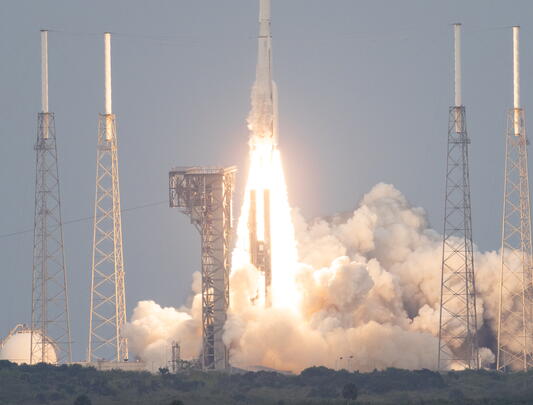Over one million satellites have been proposed, but where will they all go?
In September 2021, Rwanda announced that it was planning to launch over 300,000 satellites. Three months later, a Canadian company, having previously launched two dozen CubeSats, said it would launch an additional 100,000. Then, a French company did likewise. And SpaceX, which has already launched around 5,000 satellites, now has plans for over 60,000 more.
There are currently only about 8,000 active satellites in orbit. What’s going on?
Before a satellite is launched, a nation state must file its proposed satellite system with the International Telecommunication Union (ITU) to coordinate radiofrequency spectrum on behalf of the satellite operator, which could be a company, university or government agency.
These filings are made years ahead of the satellite launch, so the ITU can oversee coordination between different satellite operators and ensure that new satellite signals don’t drown existing ones out.
One million filings
In a new Policy Forum article published in Science, we found that, between 2017 and 2022, countries collectively made filings for over one million satellites across more than 300 separate systems of multiple satellites working together, known as constellations.
This creates two intertwined problems. Either many of these satellites will actually be launched, causing an environmental crisis through thousands of rocket launches into increasingly crowded Earth orbits, or operators are filing for more satellites than they intend to launch, perhaps with a view to hedging their bets, getting investor attention or selling the portions of radio spectrum for profit.
A closer look shows that the latter option is more likely.
Congested orbits
If even 10 per cent of the filed-for satellites launch, low Earth orbit would become congested with over 100,000 additional satellites. Collisions between satellites would generate space debris, which would in turn cause further collisions.
Reentering satellites would burn up in the atmosphere, potentially affecting the climate, while surviving pieces of debris might strike people or aircraft. We already face these risks today, but they would increase by an order of magnitude.
The problem may be more mundane, meaning that satellite operators are fiddling the numbers. Take E-Space, the French company. It is behind both the 337,320-satellite constellation filed through Rwanda in 2021, and a 116,640-satellite constellation filed through France in 2023.
Despite these ambitious filings, the company’s CEO, Greg Wyler, said it is planning for “at least 30,000 satellites,” while its director of product development mentioned “just a few thousand satellites.” Are any of these numbers real?
Countries of convenience
There are more signs that companies are attempting to game the ITU system.
OneWeb, which has 634 satellites in orbit, has made filings for 6,118 more satellites through three countries: Mexico, France, and the United Kingdom.
SpaceX has made filings through the United States, Norway, Germany, and now Tonga. It is unclear why this is happening, but all these states have different administrative rules — and fees — associated with satellite filings.
In the global shipping industry, flag-of-convenience governments register ships for companies that seek lower operating costs through looser regulations and lax enforcement. Over 44 per cent of the world’s ships by tonnage are registered in just three countries: Panama, Liberia, and the Marshall Islands. These ships historically have worse safety records and poorer labour conditions.
Tonga, now home to SpaceX’s October 2023 filing for 29,998 satellites, has filed for satellites before. In the 1980s, it filed for 16 satellite slots, eventually gaining nine slots which it promptly leased to foreign operators.
Other satellite operators weren’t happy; one even moved a satellite into one of Tonga’s slots in protest. Yet Tonga made millions of dollars through the leases.
Updating the rules
The recent megaconstellation filings are of unprecedented size, raising multiple challenges. The ITU aims to prevent interference between satellites by modelling their signal power output, and the proliferation of satellites and the splitting of filings between different states are making that difficult.
The ITU — which is a United Nations agency that predates the UN, making it the oldest agency in the organization — has well-established processes for updating its rules. The 193 member states meet every three to four years at World Radiocommunication Conferences, where new rules are debated and adopted.
In 2019, member states agreed to create “milestones” for the deployment of satellite constellations: launch 10 per cent of satellites within two years of the first launch, 50 per cent within five years, and the whole constellation within seven years. However, the first satellite can be launched up to seven years after the filing, giving companies considerable time and flexibility.
The ITU should consider speeding up this process. It could also introduce fees that disincentivize large or speculative filings.
Environmental responsibility
The Secretary General of the ITU, Doreen Bogdan-Martin, has said the ITU is increasingly prioritizing space sustainability. But it must balance that goal with its mandate, which focuses on radio spectrum management.
From November 20 to December 15, 2023, the ITU member states convened in Dubai for the World Radiocommunication Conference. But don’t expect radical changes; any proposals are unlikely to be finalized before the next conference in 2027.
And who knows what SpaceX, E-Space, and other companies will get up to before then?![]()
Ewan Wright is a PhD candidate in Interdisciplinary Studies at the University of British Columbia and Andrew Falle (BA'20) is a Research Coordinator and Junior Fellow at the Outer Space Institute at the University of British Columbia.
This article is republished from The Conversation under a Creative Commons license. Read the original article.
![]()



























